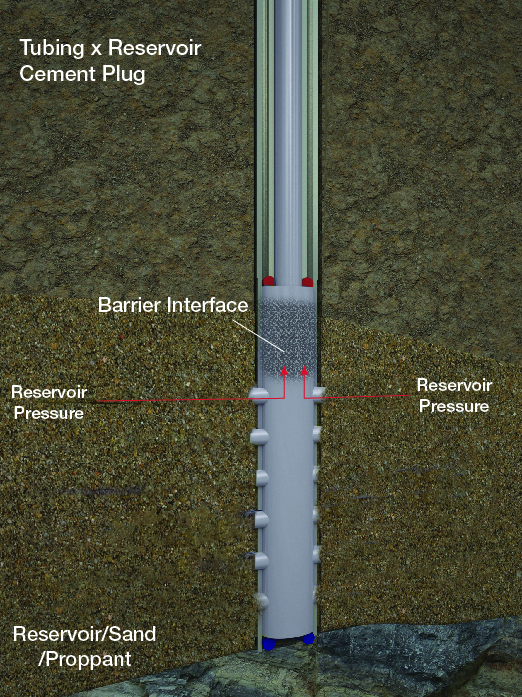Well interventions serve to address a wide variety of objectives. In many cases, the intent is to repair a failed barrier in the well, which is required to return the well to production. The interventions discussed in this article will reference occurrences where the failed barrier is designed for pressure isolation and/or the well conditions have changed resulting in unwanted fluid communication within the well. These types of interventions are usually casing/tubular leak repair, annular or sustained casing pressure repair and formation abandonment.
Wild Well Control has engineered a new multicomponent epoxy resin called ControlSEAL that is designed for oil and gas well interventions. The epoxy resin maintains unique and compelling properties that optimize this material for barrier creation and repair, namely adhesion strength and resistance to chemical degradation.
Cement limitations
Cement usage is long-established in well construction. However, the material, still widely used, presents limitations in certain intervention type applications, including difficult fluid placement and insufficient barrier integrity.
In many intervention operations, flow paths are restricted, making fluid placement difficult. This might be a function of working through completion tubing, small channels in annular spaces or permeable/unconsolidated formations. These restricted flow paths offer two challenges to the use of conventional cements. Cement slurries require a stable ratio of water and cement held static at depth of interest to set and form a solid material. In restricted geometries, this ratio can be compromised as solids often separate from the slurry and cause blockages and/or pack-off. Cement also is highly vulnerable to the effects of contamination. This is mitigated in primary well construction with the use of large fluid spacer volumes and slurry excess. In most intervention work, the restricted geometries do not allow the use of these large volumes, making the effects of contamination more severe.
Barrier construction is much more than the compressive strength of the barrier material as is commonly and inadequately referenced when validating cements. The material must adhere to its environment to create a pressure seal, and it must remain adhered and competent in the surrounding fluids for an extended period.
Shear-bond testing confirms that cement systems are fundamentally insufficient adhesives. This lack of chemical adhesion to wellbore interfaces only can be mitigated by increasing the surface area of the interfaces. The friction pressure required to migrate past these unbonded interfaces creates the impression of a pressure seal. The volumes to create this artifact often are not feasible in many intervention treatments.
Chemical exposure testing confirms that cements are highly susceptible to early degradation in the presence of many common wellbore fluids. Long-term well diagnostics in regions like the Gulf of Mexico (GoM) and North Sea continue to shed light on the severity of this characteristic.
Case study 1: Formation shutoff/ reservoir abandonment
Up until the recent improvements in shale fracturing technologies, traditional reservoir formations were most commonly composed of permeable rock. Though permeable, the flow paths do not permit the flow of a solids-carrying fluid like cement. For this reason, when cement is used in an attempt to abandon these formations, regardless if the objective is abandonment or to mitigate water production, the solids are screened out of the slurry as the water is squeezed into the permeable formation and a pack-off occurs (Figure 1).

FIGURE 1. A conventional cement plug is unable to pass through perforations, limiting the barrier to a tubular plug. (Source: Wild Well Control)
This results in the barrier element, in this case the cement, existing only within the tubular. Barrier integrity relies on the cement to maintain a durable seal across this limited surface area.
By utilizing ControlSEAL, the point of vulnerability is shifted by changing the barrier interface. The resin can be squeezed into the formation and used to physically change the permeability of the rock to zero. Not only has the bonded surface area increased exponentially but this is accomplished with an impermeable, high-performance adhesive that is naturally resistant to corrosion (Figure 2).

FIGURE 2. Resin is squeezed through perforations without risk of bridging/pack-off (left), filling the porosity of both reservoir and proppant (center). Proppant is consolidated, eliminating reservoir porosity (right). The barrier interface is now expanded within the formation and not vulnerable to bond failure known to tubular cement plugs. (Source: Wild Well Control)
An offshore well in Central Asia had a relatively large reservoir footage and sufficient production until increasing water cut continued to grow. The operator’s objective was to isolate the lower 50% of the reservoir permanently without compromising the ability to continue to produce from the upper portion of the formation sands. Resin was pumped to the top of the formation initially by using the bullhead squeeze method.
Pumping was discontinued to allow the resin to free fall to the bottom of the formation sand. Once the resin settled, the well was pressured again to squeeze the resin into only the desired lower portion of the reservoir. Pressure was held following squeeze treatment to allow resin to cure under static well conditions.
This resulted in a 70% reduction in water production that was confirmed instantly. Though the water cut had increased gradually from this original reduction, it is believed to be a function of reservoir oil depletion and not associated with the resin barrier integrity.
Case study 2: Sustained casing pressure repair
There are a number of challenging issues associated with sustained casing pressure (SCP). To clarify, SCP generally is referenced as reservoir and/or formation pressure that is unintendedly present in a well annulus. Most wells have a number of annuli, and SCP can exist in any. In primary well construction, these pressures are supposed to be isolated to their respective depths in the well through primary cement barriers. Fundamentally, SCP in most wells exists directly as the response of a failed primary cement job.
This can happen at any stage in the life of the well but often is found in later stages, suggesting that the cement barrier would have failed over time or well function. Repair efforts require hydraulic access to the annuli containing SCP either by perforating or section milling into annuli from the main wellbore or through the wellhead access valves. Though pressure communication exists, the injection pressure and rates into these annuli, as they were previously cemented, are very high pressure and low injectivity. Failure mechanisms with this profile often are thought to be the cause of microchanneled and/or partially de-bonded cement. Resin can be squeezed into these channels and used to adhere the previously failed cement to tubulars and formations without the pack-off and contamination risk of cement usage.
During an ongoing plug and abandonment campaign in the GoM, after the final surface plug (cement) was set, it was observed on a number of wells that gas bubbles continued to migrate up through the casing annulus and intermediate tubular. Regulation in this region requires no observed gas flow for 30 minutes.
To eliminate the presence of gas flow (bubbles) and achieve compliance, a section mill was placed near the top of the potentially failed surface cement plug to allow access to the annular and intermediate tubular. An inflatable packer was placed in the sectioned milled area using a work string. A balanced plug was placed below the inflatable area using a small diameter tubing run through the work string. The tubing was removed and pressure was applied to squeeze the resin plug into microchannels and existing fractures, achieving the objective of eliminating gas flow.
Recommended Reading
Defeating the ‘Four Horsemen’ of Flow Assurance
2024-04-18 - Service companies combine processes and techniques to mitigate the impact of paraffin, asphaltenes, hydrates and scale on production—and keep the cash flowing.
AI in Oil: Revolution’s Coming, but Tech Adoption Remains Tentative
2024-04-05 - CERAWeek experts say AI will disrupt oil and gas jobs while new opportunities will emerge as the industry braces for an AI-driven workflow transformation.


